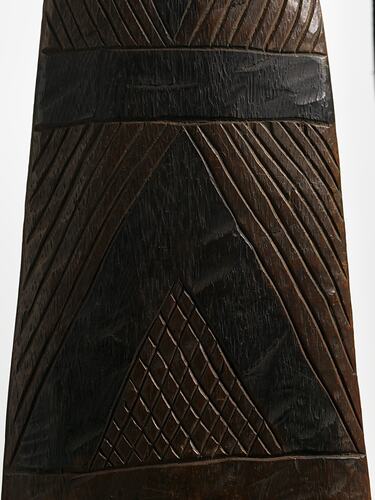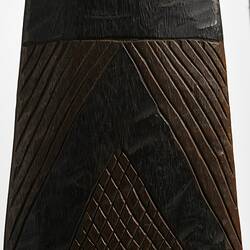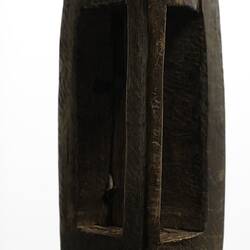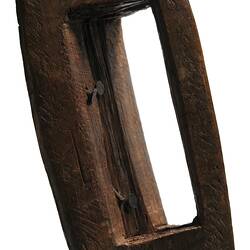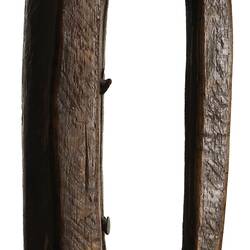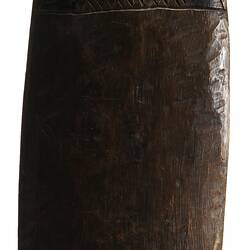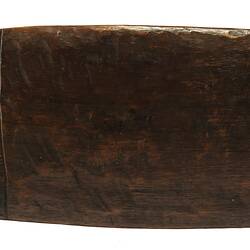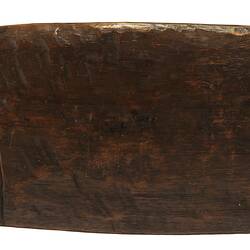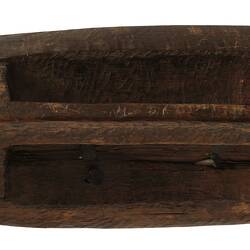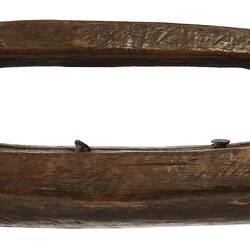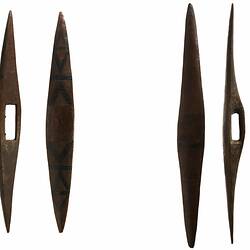Summary
This mulga (parrying shield) was acquired from one of the men living at Coranderrk Aboriginal Station in 1906. Reports from this time list 58 residents and further research is being undertaken to identify the name of the man who made this mulga. In addition to working on the station and farm, the men also made wooden implements to sell to visitors and tourists who came to Coranderrk.
Mulga were usually made from the locally available hardwood, although Red Ironbark and Yellow Gum were often preferred. Incised decoration, such as on this mulga, was done while the wood was raw and green, as timber hardens over time and becomes difficult to work. Once engraved, the shield would then be dried, before being rubbed with ochre and animal fat, which made the wood resistant to water and to cracking. Charcoal was mixed with ochre and animal fat for the black pigment used in decorations on wooden implements.
Local Name
Mulga
Physical Description
Wooden shield which is broadest in the mid-section and tapers to a point at each end. The shield is elliptical in cross-section, the broadest side being the incised front. The handle is carved into the body of the shield at the back. The front of the shield is decorated with the incised concentric bands, chevron, with two half and two full black diamonds. Inside the four diamond shapes is cross hatching. The two half diamonds are positioned either side of the broad undecorated mid-section of the shield face. In the base of the handle are four aged and slightly corroded nails. The surface has a dark brown patina with lighter mottling particularly on the undecorated middle panel on the incised front.
Significance
In 1863, desperate for a safe haven for their people which would protect them from the ravages of colonisation, Kulin leaders Simon Wonga and William Barak, with the help of Superintendent John Green, established the Coranderrk Aboriginal Station. At the junction of the Yarra River and Badger Creek near the town today known as Healesville in the Yarra Valley, Coranderrk aspired to be a self-supporting community and its 4850 acres became one of the most productive stations in the Yarra Valley. By 1875 more than 100 Aboriginal residents worked and lived at Coranderrk, building and living in their own family homes and constructing a school for their children. The station ran a substantial milking herd, horses, pigs, poultry, orchard, a market garden and a working hop field. The Kulin people at Coranderrk, unlike many other Kulin peoples living in religious mission stations set up throughout Victoria, were free to continue to hunt and gather traditional foods alongside their work on the station. Many Kulin men also earnt wages shearing sheep for neighbouring graziers while women made money selling their own handmade goods such as baskets and rugs to the many tourists who visited the area.
In 1923, largely as a result of being too successful, the government officially shut down Coranderrk Station which was now on much sought-after prime land. Many of its residents were removed to Lake Tyers Mission in Gippsland but several residents refused to leave.
More Information
-
Object/Medium
Shield
-
Maker
-
Locality
-
Date Produced
-
Collector
-
Date Collected
-
Object Measurements
620 mm (Length), 70 mm (Width), 80 mm (Height)
-
Classification
-
Date Made
-
Maker
-
Clan/Language Group
-
Place Made
-
Indigenous Region
-
Keywords
-
Type of item
-
Discipline
-
Category
-
Collecting Areas
